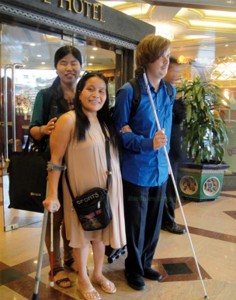Ina
Endena is concerned at the impact of the new rice varieties on Agawa community
life. Since the introduction of the biit, the synchronized planting
season has been inexistent. During a community holiday for example, the farmers
usually break the ubaya or community taboo just to tend their fields for
the application of needed fertilizers or pesticides.
BY
ARTHUR L. ALLAD-IW
Northern Dispatch
Posted by Bulatlat
Northern Dispatch
Posted by Bulatlat
I've seen her many times in
different occasions involving grassroots organizations – in Mountain Province or
in any part of Cordillera and elsewhere. In most of these activities where I had
seen her, human rights issues were the main topics in the discussions. She comes
from a place that had often been militarized and as a consequence, human rights
violations were usually reported.
On the day before the
celebration of our paper’s fourth anniversary as a weekly and 17th as a news
dispatch, Baket Endena – a leader of the Cordillera Peoples Alliance (CPA) in
her native Mountain Province as well as the Innabuyog-GABRIELA – came with a
pizza to share with the Nordis staff, who were then busy preparing for the
occasion.
This time, my conversation
with Ina Endena, as most fondly call her, is focused on agricultural practices
in their village in Agawa, Besao in Mountain Province.
I am touched at how she
laments that new rice varieties are slowly displacing indigenous varieties. She
is saddened at the thought that her community practices are slowly
disintegrating due to the introduction of these new varieties into the
Cordillera interior.
At first, it is hard to
comprehend how the entry of the new varieties has weakened indigenous practices.
But she explained with such clarity that I realized that we have to respond to
an urgent call from this 82-year-old elder who is still active in grassroots
organizing.
Ina Endena described the
role of the dap-ay, an indigenous socio-political system where elders
gather and talk about the beginning of the agricultural activities.
In end-September, the
elders declare three days as ubaya or community holidays. They
perform a ritual, observe signs, and if all the indications appear good then
they start the rice seedbed preparation in the padog (rice field
specifically designated for that purpose). The ubaya also starts the land
preparation. Work is done simultaneously in all rice fields. The community
residents do the preparation, planting and harvesting in synchrony with the
environment. A tradition of thanksgiving is also performed after every harvest.
Outside influences, she
says, contribute to the weakening of their indigenous practices. She observed
this in what is happening to their indigenous rice varieties called the bayag
(literally, a long period of time). These are slowly being set aside, she says.
These varieties include the
tupeng, ginolot, yangaw (sticky rice). She observed that those varieties
already lost are the sabsaba, kinison and matiko.
These old varieties are
being replaced by taiwan, walay (sticky rice) and others called biit
(short) as these may be planted twice a year.
She admits that it takes a
longer wait to harvest the bayag variety, but she prefers it to the
introduced biit because these are raised with just natural fertilizers
like sunflower leaves, and a local variety of grasses, among others. She pointed
out the biit, though planted twice in a year, need more commercial inputs
like fertilizers and pesticides. She observed that these inputs are not only
expensive but makes the land barren and therefore, dependent on these
agro-chemicals.
Ina Endena is concerned at
the impact of the new rice varieties on Agawa community life. She observes that
since the introduction of the biit, the synchronized planting
season has been inexistent. In the declaration of a community holiday for
example, the farmers usually break the ubaya or community taboo just to
tend their fields for the application of needed fertilizers or pesticides.
She also observes that
indigenous agricultural practices are environment-friendly.
Before our interaction
ended with lots of lemon grass tea and brewed coffee that washed the pizza down
our throats, I felt the need to heed her recommendations to adopt indigenous
systems. After all, these practices have been proven to be cost-effective and
environment-friendly by indigenous communities like Agawa in Mountain Province.
Northern Dispatch / Posted by Bulatlat
© 2006 Bulatlat
■
Alipato Media Center













